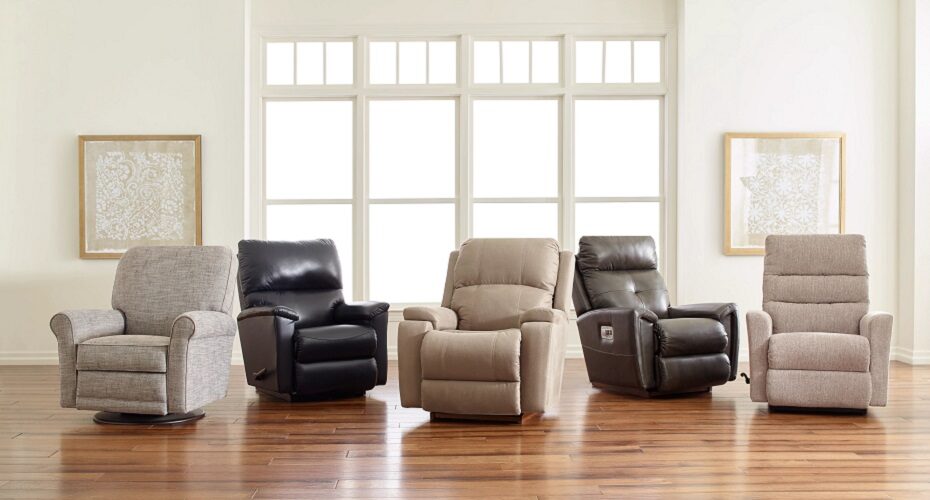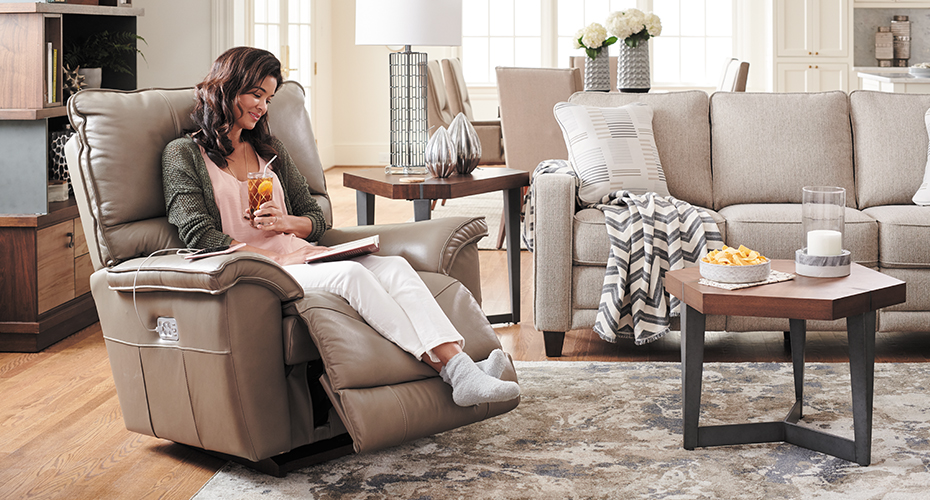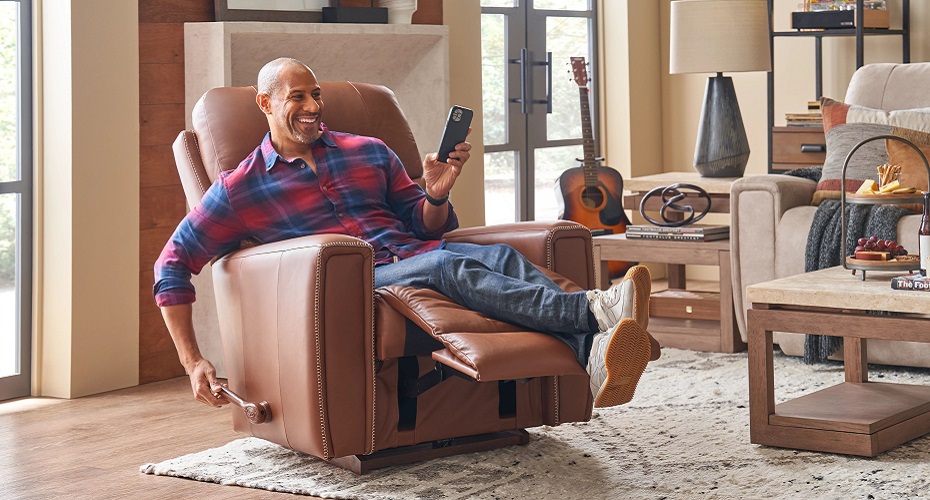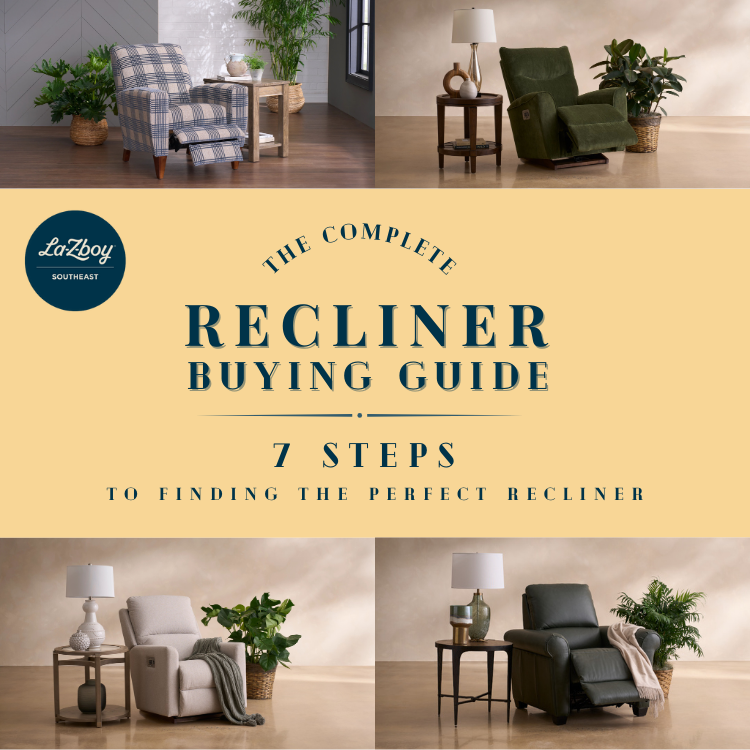5 Science-Backed Benefits of Recliners (That Go Way Beyond Comfort)
La-Z-Boy Southeast | October 15, 2025

Think recliners are just for lazy Sundays and football games? Think again. That chair your grandpa swore by might be one of the smartest furniture investments you’ll ever make.
What Makes Recliners Different?
Unlike regular chairs that force your body into rigid positions, recliners work with your natural anatomy. When you recline, you’re not just getting comfortable—you’re giving your body a biomechanical break it desperately needs.
As the inventor of the recliner, La-Z-Boy knows a thing (or 5) about them. Here are some important benefits to consider before making an investment in a new recliner:
5 Benefits of Recliners
1. They’re Actually Good for Your Spine
The short answer: Sitting at 90 degrees all day compresses your spine. Reclining to 135 degrees takes the pressure off.
When you sit upright in a regular chair, your spine supports about 90% of your upper body weight. Ouch. But when you recline to that sweet spot around 135 degrees, the backrest takes over most of the work. Your intervertebral discs get a break, which means less back pain and fewer long-term spine issues.
This is why people with chronic back pain often swear by their recliners. It’s not just psychological comfort—it’s physics working in your favor.

2. Elevating Your Feet Does More Than You Think
Here’s something your body knows but your brain might not: gravity is exhausting.
All day long, your heart pumps blood down to your feet, then has to work against gravity to get it back up. When you elevate your legs above heart level in a recliner, you’re essentially giving your circulatory system a helping hand.
Real benefits include:
- Reduced swelling in legs and feet
- Less strain on your heart
- Decreased inflammation throughout your body
- Faster recovery after long days standing or sitting
Pregnant women and people with circulation issues have known this secret for years. But honestly? Everyone benefits from kicking their feet up regularly.
3. Your Stress Levels Drop (Literally)
Recliners trigger something called the “relaxation response”—a physiological state discovered by Harvard researcher Herbert Benson in the 1970s.
When you recline and your muscles start to release tension, your body begins producing fewer stress hormones like cortisol. Your breathing naturally slows and deepens. Your blood pressure can drop by several points within just 10-15 minutes.
It’s not magic. It’s just your nervous system shifting from “fight or flight” mode to “rest and digest” mode. And unlike meditation apps or breathing exercises, a recliner makes this happen almost automatically.

4. They’ve Evolved Way Beyond the Dad Chair
Remember those bulky leather recliners from the ’90s? The ones that screamed “middle-aged man cave”?
Modern recliners have had a serious glow-up. You can now find:
- Wall-hugger designs that need just 4 inches of clearance (perfect for apartments)
- Power recliners with USB ports and adjustable lumbar support
- Swivel gliders that rock, swivel, AND recline
- Sleek contemporary styles that look nothing like traditional recliners
Some models let you adjust the footrest and backrest independently, so you can put your feet up while sitting upright to read, or recline your back while keeping your feet down. The old “all or nothing” recliner is extinct.
5. They’re a Smart Long-Term Investment
Here’s the thing about quality furniture: it either costs more upfront or costs more over time through replacements.
A well-built recliner typically lasts 10-15 years with daily use—far longer than most sofas or accent chairs. The mechanism is simpler than you’d think (basically a lever and spring system), which means fewer things to break.
Plus, as you age or if your mobility changes, a recliner adapts with you. Power lift models can help people transition from sitting to standing, which means the chair you buy at 40 might still be serving you well at 70.
The Bottom Line
Recliners aren’t just about watching TV in maximum comfort (though let’s be honest, that’s a solid perk). They’re about giving your body the positional variety it craves, supporting your circulatory system, and creating a genuine relaxation zone in your home.
The question isn’t really “Should I get a recliner?” It’s “Why did I wait this long?”
Quick FAQ
Q: Will a recliner hurt my posture?
A: Not if used correctly. Excessive time in any position isn’t great, but alternating between upright sitting and reclining is actually better for your spine than sitting at 90 degrees all day.
Q: How much should I spend?
A: Quality recliners typically range from $900-$2,000. Consider it an investment—you’ll use it almost daily for a decade or more.
Q: Do I need a power recliner or is manual fine?
A: Manual recliners are perfectly fine for most people and require no power outlet. Power recliners offer more precise positioning and are essential if you have mobility limitations.
Q: How much space do I actually need?
A: Traditional recliners need 1-2 feet behind them to fully recline. Wall-hugger models need just 4-6 inches from the wall. Measure your space before shopping.
Check Out These Additional Resources
- Learn how to Pick A Recliner to Fit Your Body Type
- Get a feel for it yourself! Stop into any of our La-Z-Boy Furniture Galleries in NC, SC, and GA. We’re here to to help you pick a recliner that best suits you.



